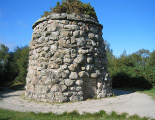MPs hail Culloden visitor centre
Members of all parties agree battlefield project sets the highest of standards
The Culloden Battlefield experience near Inverness has been praised by Westminster politicians.
The ground-breaking archaeological work carried out by the National Trust for Scotland and the innovative approach to telling the story of the battle sets the standard that all UK battlefield sites should strive for, according to an influential all-party parliamentary group.
In a letter to the charity’s chairwoman, Shonaig Macpherson, Lord Faulkner, who chairs the group, said: “It is the view of the all-party group that the work carried out at Culloden is at the forefront of battlefield interpretation, and we therefore have hopes that the high standard the trust has set will be emulated at other sites across the United Kingdom.”
Read full article at News for Culloden
Archaeology at Culloden
“Archaeologists have discovered that the Battle of Culloden was closer and more bloody than first thought. For the first time, metal detectors and excavation work at the battlefield have unearthed the exact spot where the Jacobites clashed with the government forces in hand-to-hand combat during the 1746 battle which marked the end of the '45 rebellion.
Dr Tony Pollard, of the "Two Men in a Trench" TV programme and a team from the Centre for Battlefield Archaeology at Glasgow University, not only settled the controversy about location, but revealed that the forces of Bonnie Prince Charlie came far closer to victory than some accounts have suggested.”

Culloden may have been the last battle of the Jacobite risings, but it was also the first battlefield in Scotland to be subject to archaeological investigation. The first phase of this long-term project took place in 2001 as part of the BBC television series Two Men in a Trench but has since continued under the auspices of the National Trust for Scotland as part of the Culloden Battlefield Memorial Project. The investigation, carried out initially by GUARD and latterly by the Centre for Battlefield Archaeology at the University of Glasgow, has included topographic, geophysical and metal detector surveys along with archaeological excavation. Read more...
Who are we?
The All-Party Parliamentary War Heritage Group, chaired by Lord Faulkner of Worcester, has over 90 members.
Co-secretaries are Peter Barton, historian & author of several books on WW1 in association with the Imperial War Museum & Professor Peter Doyle, a military terrain specialist.
Some useful links
- Commonwealth War Graves Commission
- Imperial War Museum
- UK National Inventory of War Memorials
- War Memorials Trust
- The War Graves Photographic Project
- The Battlefields Trust
- Centre for Battlefield Archaeology
- The Western Front Association
- British Commission for Military History
- United Kingdom Parliament
 90 years of Remembrance
90 years of Remembrance

 17 March 2010:
17 March 2010: 